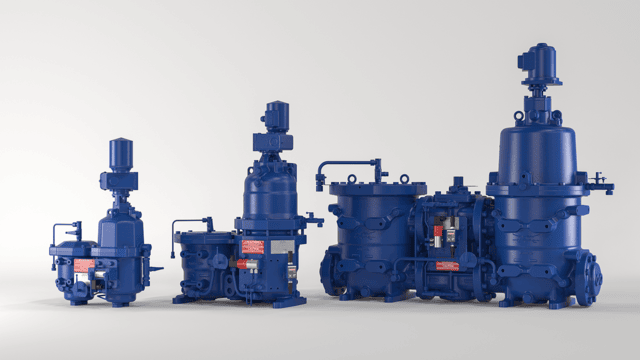Fuel oil filters
Moatti fuel oil filters build on the innovative Alfa Laval Atrium 2.0 technology for automatic self-cleaning filters. Available in several sizes and configurations, they handle fuel oil for all four-stroke and two-stroke engines, whether they are running HFO, MDO/MGO or biofuels. Highly compact with no compromise on filtering area, the provide high efficiency fine filtration with virtually no pressure drop for optimal protection against catalytic fines.
Compact engine protection
- Easy installation
- Minimal pressure drop across the filter
- Low and predictable maintenance
Biofuel-ready
Moatti fuel oil filters are suitable for use with biofuels of the following type:
- Fatty Acid Methyl Esters (FAME), compliant with EN 14214
- Hydrotreated Vegetable Oils (HVO)
- Blends of the above with ISO 8217–compliant hydrocarbon fuels
Products
Moatti 152 filters
With high-efficiency fuel oil filtration for four stroke or small two stroke engines – the 152 filter is a proven filter solution, protecting your engine from catalytic fines and fuel instability
Moatti 180 filters
Our most compact system yet, the 180 filters don’t compromise on filtering area while still delivering high efficiency fine filtration with virtually no pressure drop.
Moatti 290 filter
Alfa Laval Moatti 290 filters utilize the original Atrium technology for automatic self-cleaning filters. Our most modular range, the 290 filters will adapt to meet your requirements with precision.
Fuel oil filters
The F type range of Alfa Laval automatic fuel oil filter systems provides effective full-flow filtration of fuel oil (FO), heavy fuel oil (HFO) and marine diesel oils (MDO) up to 700 cSt/50°C. These fuels are widely used in modern two-stroke and four-stroke diesel engines, and the quality and cleanliness of such fuel has an important influence on engine efficiency, fuel consumption, reliability and service life.
This range of automatic fuel oil filter systems only requires very limited investment yet helps ensure reliable engine operation, along with peace of mind for those dependent on the engine working as intended. The robust, space-saving design makes these units easy to install as well as to retrofit as upgrades to existing installations.
These units use fuel oil that has already been filtered to backflush the filters, doing away with any need for a compressed air supply. This backflushed oil is then cleaned by refiltration in a special filter-equipped diversion chamber (which also uses the same backflushing principle) before being recirculated into the system. This diversion chamber acts as an automatic maintenance-free sludge treatment system, collecting and concentrating the particles backflushed from the full-flow chamber and the subsequent cleaning process into a concentrate sludge.
This means there is no need for a sludge treatment unit involving either manual cleaning or consumables that need replacing. Installation is recommended on the circulation side (hot loop) of the fuel oil system for maximum engine protection. Eliminating the use of colder backflush media prevents thermal shocks that can result in the formation of asphaltenes in the fuel. Options are available for additional features, such as a drain valve with an automatic timer, and a built-in changeover valve with bypass filter, enabling operations to continue uninterrupted during routine maintenance.
How it works
The basic principle behind Alfa Laval automatic fuel oil filter systems is that the oil is pumped through the filter towards the engine – after first passing through a strainer that removes any larger foreign objects that might be present in the system – left behind after maintenance, for example.
Full flow filter elements
A distributor, driven by an electric motor on top of the filter housing, then feeds the fuel oil through a series of full-flow filter elements. Each filter element comprises a filter frame and filter screen, and is divided into sections by ribs. The individual filter elements are assembled into a stack of filter discs, with the sections forming eight independent, full-flow filtering columns.
The distributor rotates on a regular basis, filling seven of the eight full-flow filtering columns. Solids collect on the filter surface and the filtered oil flows to the engine.
Backflushing of solids
In the eighth column, the solids that have been collected are removed by backflushing a small amount of the filtered oil through a passage in the distributor to the diversion chamber. This means all the filter columns are backflushed once every time the distributor rotates in full – which normally takes up to two minutes.
The backflushed oil, which now contains the filtered solids, then enters the diversion chamber and passes through seven of the eight filtering columns here before being led back to the deaerator (in a so-called “hot side“ system) or to the suction side of the supply pump (in a “cold side“ system). At the same time, backflushing by clean oil takes place in the eighth column and the solids thus removed settle to the bottom of the diversion chamber, where they are periodically discharged through a drain cock.
A pressure drop indicator is fitted between the inlet and outlet of the full-flow chamber, providing an alarm signal should pressure drop reach a dangerous level.
The process of automatic backflushing is driven by the small pressure difference between the clean oil outlet and the backflushed oil outlet of the filter.



